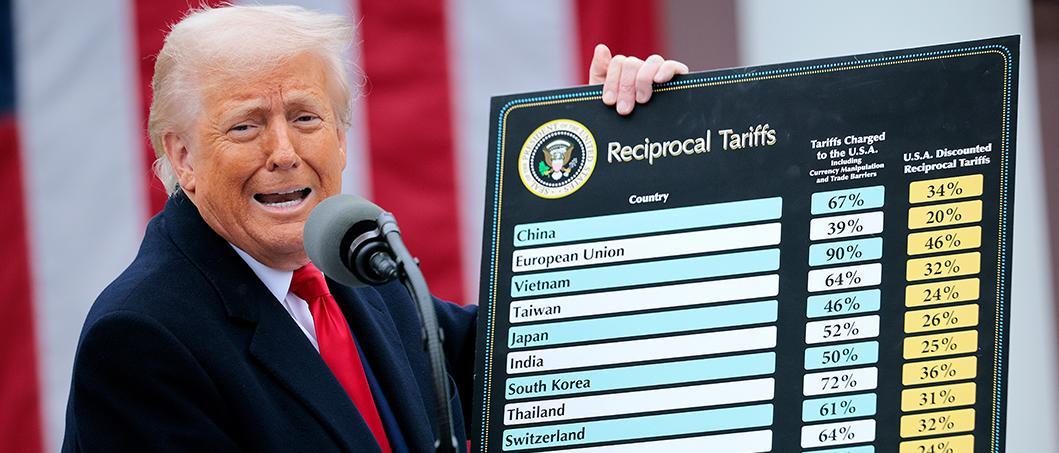Donald Trump's "Liberation Day" has shaken the world. It was not only the level of the announced tariffs that shocked, but also their bizarre derivation. The stock markets have collapsed, the US Treasury market has been shaken by an earthquake and the US dollar is weakening. "Trumponomics" has the potential to plunge the US economy into recession. For the rest of the world, however, the US tariff policy could be less of a burden in the medium term than many currently fear.
The USA and world trade in goods
In 2023, the volume of global trade in goods (expressed as the sum of exports and imports) totalled around 44 trillion US dollars (Fig. 1). The USA's share was 12 per cent. The European Union and China accounted for 31 and 14 per cent respectively (Fig. 2).1 The aim of the Trump administration's tariff policy is to equalise all bilateral and thus the entire US trade balance. In 2023, the trade deficit (according to UN data) was around USD 1 trillion. In the same year, the USA accounted for 15 per cent of the world's total imports and 9 per cent of its exports. Little has changed in these ratios for years (Fig. 3).
A sample calculation for the trade effects
In all likelihood, it will not be possible to equalise the trade balance by reducing imports to the existing level of exports. As some imports are necessary for the production of export goods, exports will also be affected by import restrictions. For our example calculation below, we assume that this affects 20 per cent of exports. As a result, exports fall by 0.4 trillion US dollars to 1.6 trillion. If the trade balance is to be balanced at this level of exports, imports must fall by USD 1.6 trillion. Taken together, this results in a decline in US trade flows of 2 trillion US dollars. This will reduce total global trade in goods by a manageable 5 per cent. At the same time, it can be assumed that some of the goods not sold in the USA will be diverted to other regions of the world (at more favourable prices). "Trade destruction" and "trade diversion" correspond to the phenomena of trade creation and trade diversion known in the economic literature that arise when a customs union is created.
For our example calculation, we assume that trade diversion can compensate for half of the trade loss. The bottom line is that total global trade in goods would fall by just 2 per cent, or less than one trillion US dollars. Given the magnitude, global trade could easily cope with this.
Financial markets could relax again in the medium term
However, the reaction of the financial markets to "Liberation Day" was far more serious than our sample calculation suggests. There were probably two main reasons for this. Firstly, the markets rightly fear that the uncertainty created by Donald Trump will plunge the US economy into recession. Secondly, they fear that the countries affected by the US tariffs will respond with counter-tariffs, leading to a trade war. Memories of the Smoot-Hawley Tariff Act passed in June 1930 have been awakened. In response, many of the USA's trading partners introduced retaliatory tariffs. World trade shrank by around 60 per cent, exacerbating the Great Depression of the early 1930s. Export-orientated countries such as Germany and Canada were particularly affected. US farmers and industries also suffered from countermeasures from abroad.
However, a repeat of this development can be avoided if the countries affected by the US tariffs refrain from escalation. In particular, the negative trade effects of the US tariffs could be mitigated by greater trade integration in the rest of the world. The adjustment costs triggered by the US tariff shock are hardly avoidable in the short term. In the medium term, however, the US could be the only major loser from Donald Trump's tariff policy. As soon as this realisation reaches the financial markets, they are likely to relax again.
___________________________________________________
1 The EU data includes trade within the EU.
Legal notice
The information contained and opinions expressed in this document reflect the views of the author at the time of publication and are subject to change without prior notice. Forward-looking statements reflect the judgement and future expectations of the author. The opinions and expectations found in this document may differ from estimations found in other documents of Flossbach von Storch SE. The above information is provided for informational purposes only and without any obligation, whether contractual or otherwise. This document does not constitute an offer to sell, purchase or subscribe to securities or other assets. The information and estimates contained herein do not constitute investment advice or any other form of recommendation. All information has been compiled with care. However, no guarantee is given as to the accuracy and completeness of information and no liability is accepted. Past performance is not a reliable indicator of future performance. All authorial rights and other rights, titles and claims (including copyrights, brands, patents, intellectual property rights and other rights) to, for and from all the information in this publication are subject, without restriction, to the applicable provisions and property rights of the registered owners. You do not acquire any rights to the contents. Copyright for contents created and published by Flossbach von Storch SE remains solely with Flossbach von Storch SE. Such content may not be reproduced or used in full or in part without the written approval of Flossbach von Storch SE.
Reprinting or making the content publicly available – in particular by including it in third-party websites – together with reproduction on data storage devices of any kind requires the prior written consent of Flossbach von Storch SE.
© 2024 Flossbach von Storch. All rights reserved.








